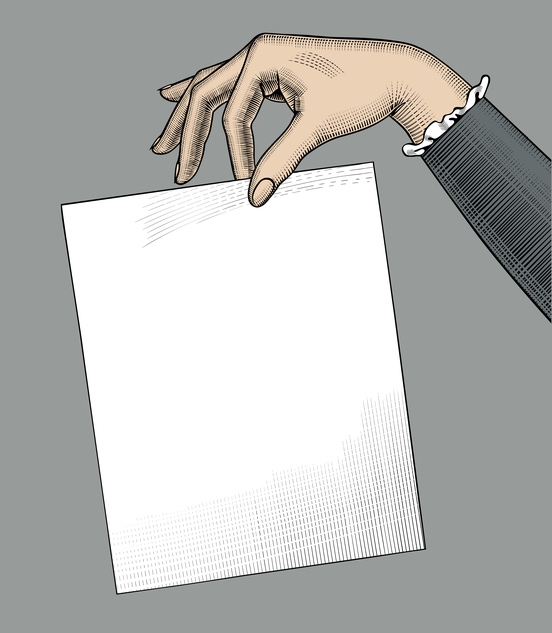You have /5 articles left.
Sign up for a free account or log in.

Istockphoto.com/maystra
Dear Mentors,
I just can’t seem to get this new article started. Up until this fall, I’ve had a pretty productive year. I collected all the data I needed to write this piece. I even spent the entire summer analyzing the data. At the beginning of the semester, I felt like this article was going to write itself. But every day I sit down to write, I keep facing the same problem: the curse of the blank page. Even on days when I have all the time in the world to write, I can’t manage to squeeze out more than a few sentences. And every day that passes, my inner critic gets louder and louder.
Please help!
Cursed by the Blank Page
Dear Cursed,
Starting a new article triggers anxious feelings for many academic writers. We’ve worked with a wide range of academics -- from graduate students to endowed chairs and internationally known scholars -- who’ve encountered the curse of the blank page.
Given the sheer amount of time, effort and energy it takes to move from a new idea to a published article, it’s no surprise that many academic writers freeze up in the presence of a blank page. It can feel overwhelming (and even scary) to stand at the foot of a mountain of work with an unclear probability of success.
Whenever we experience these overwhelming feelings, the best thing we can do is to break down the big goal into a series of small projects and tasks. In other words, instead of focusing on the entire mountain you need to climb, let’s focus on the path immediately in front of you. Remember, a journey of a thousand miles always begins with a single step.
One thing you can do in the beginning is to stack the deck in your favor. The main reasons articles get rejected from journals are: 1) a crucial flaw in methodology, findings or logic, 2) content that is a bad fit for the journal and/or 3) a manuscript that is perceived to be poorly written because it doesn’t conform to the expected guidelines of the journal.
Given that you have previously published research and fresh findings, we assume you have the ability to design a study and produce innovative results. So let’s reverse engineer the writing process to stack the deck in your favor by avoiding the other reasons your article could be rejected.
Step 1: Identify a template. First, pick a journal that you want to publish in, and let this be a collaborative and fun experience. Talk (yes, actually talk) to your friends and colleagues about those hot new findings of yours and ask them what journals they think are the best fit. That will result in lively conversations -- a consensus will emerge, and it will get you reconnected to what is important to share about your work.
Once you’ve chosen a specific journal, pick a recent article that you can use as a template. It’s ideal if you select an article that is similar in methodology and subfield. This template will allow you to deconstruct the structure of a published article so you can create mini writing projects that will fill up your blank pages.
Step 2: Calculate a word count ratio. Now that you have a recent article from your ideal journal to use as a template, go through it and calculate the word count ratio. It is a simple equation: 1) count the number of sections in the paper, 2) determine the page length of each section and 3) calculate a ratio to determine how many words should be dedicated to each section.
For example, one of us, Anthony, is a sociologist of immigration, and he used an article from the journal Ethnic and Racial Studies as his template. In total, the template article had seven sections. So he counted the pages and figured out the word count for each section:
- Introduction: 260 words
- Literature review: 780 words
- Historical context: 520 words
- Methodology: 780 words
- Findings: 2,600 words
- Discussion and conclusion: 1,300 words
- References: 780 words
- Total: 27 pages, 7020 words
If that seems confusing, watch this short video on calculating word count ratios.
For most academic writers, the simple act of breaking down the word count ratio per section is enough to start lifting the curse of the blank page because it transforms a big, scary goal (draft a new article) into a smaller, more manageable and considerably less scary set of mini projects.
Step 3: Make a plan. Once you know all of the mini projects that will take you from blank page to completed draft, estimate how many days you’ll need to dedicate to each section. You don’t have to guess -- just assume a modest writing goal of 300 to 400 words per day. Keep in mind that you don’t want to be overly aggressive on your daily goal, because you may set yourself up for failure. And be sure to not exceed the daily goal, because if you write too much in any one day, you’ll end up with a “writing hangover” the next day that will limit your progress.
Once you’ve set the daily goal, attach it to your calendar and stick to the plan as best you can.
For example, Anthony committed to 300 to 400 words per day, then put the following number of days per section in his calendar:
- Introduction: 1 day
- Literature review: 2 days
- Historical context: 2 days
- Methodology: 2 days
- Findings: 6 days
- Discussion conclusion: 4 days
Pro tip: You can add periodic days between working on each section for mind mapping, planning the next section you’ll write or editing what you’ve written. The goal is to not spend an exorbitant amount of time drafting any one section. Instead, you want to get the entire first draft of your article written as efficiently as possible.
In coaching academic writers, we’ve observed that everyone is different, and there are certainly variations by discipline. For some people, writing a literature review will take longer than writing the findings section of a paper. The key takeaway of inserting your tasks into your calendar is that you push yourself to draft the complete paper rather than get bogged down in any one section of the piece.
Step 4: Create SMART goals. For each section that you draft, take one additional step: create SMART goals for it. A SMART goal is specific, measurable, achievable, realistic and time specific. If you do this now, you’ll be able to use these same SMART goals the next time you are faced with the curse of the blank page.
For example, in the template article Anthony used, the literature review was 780 words and was composed of two subsections: 1) a summary of the existing literature and 2) a demonstration of the gaps in the literature. So your SMART goals for a literature review might look like the following:
- Make a list of the key studies or scholars that I must cite in this paper.
- Determine what gaps my research is filling.
- Schedule conversations with two trusted colleagues in my field to see if I am on the right track.
When you get clear on the necessary components of a section, you transform drafting the literature review from an amorphous mini project into a manageable and highly specific set of tasks. Now, you just have to write a 300-word essay answering these critical questions by integrating scholarly work.
Step 5: Let it go and celebrate. Once you have completed writing your various mini projects that make up the manuscript, share the draft with a couple of trusted friends who have expertise in your subfield. When you share it, be specific about the type of feedback that you need and the amount of time you want a reader to spend reviewing it.
In Anthony’s case, he asked two friends to spend 30 to 60 minutes reading his draft. He asked for this amount of time because it’s typical of the fast read that many of your reviewers will give it. The goal here is to use targeted feedback to get your paper to 80 percent, because most academic writers make two crucial mistakes that slow their productivity to a crawl: 1) workshopping papers to death and 2) trying to get your first submission to 100 percent perfection. You don’t want to hang on to papers for unusually long periods of time, and you can count on a journal’s peer reviewers to identify new things they want you to incorporate into a resubmission.
Once you’ve got your manuscript to 80 percent, submit it and celebrate! That’s right, you’re done! You’ve broken the curse of the blank page, and that means some fun treats are in order.
We hope these five steps will help you to move from feeling stuck and overwhelmed in the presence of a blank page. Breaking down a big goal -- draft and submit a new article -- into smaller mini projects that are defined by specific word counts and days in your calendar is the fastest way to get you moving forward. And it increases the probability of getting those hot new findings from your research under review and (eventually) published.
Peace and productivity,
Anthony Ocampo, associate professor at California State Polytechnic University and director of campus workshops at the National Center for Faculty Development & Diversity
Kerry Ann Rockquemore, founder of the center








